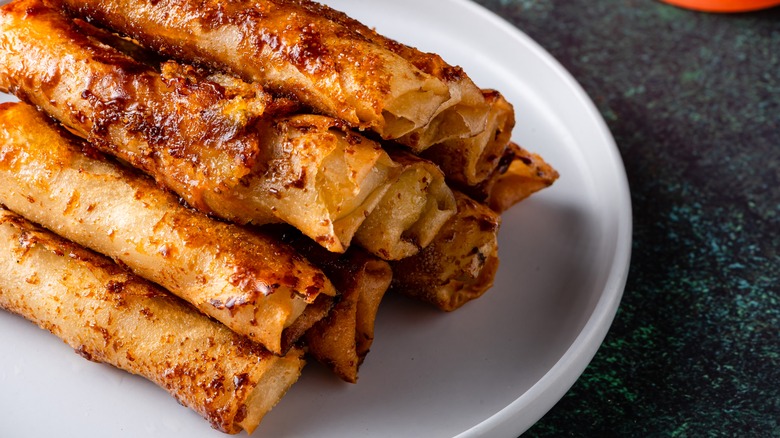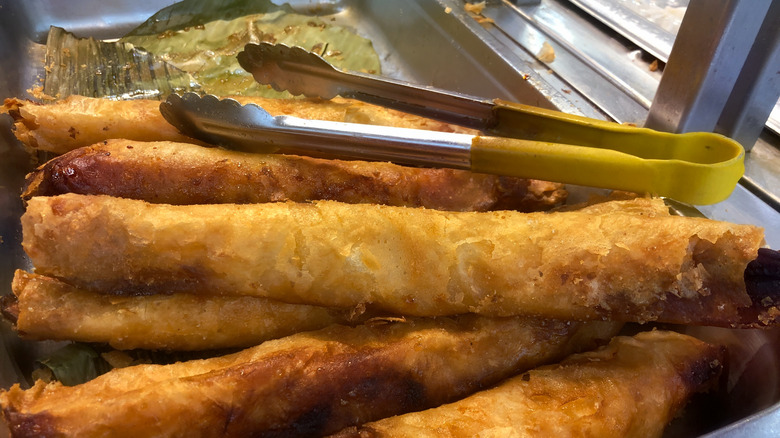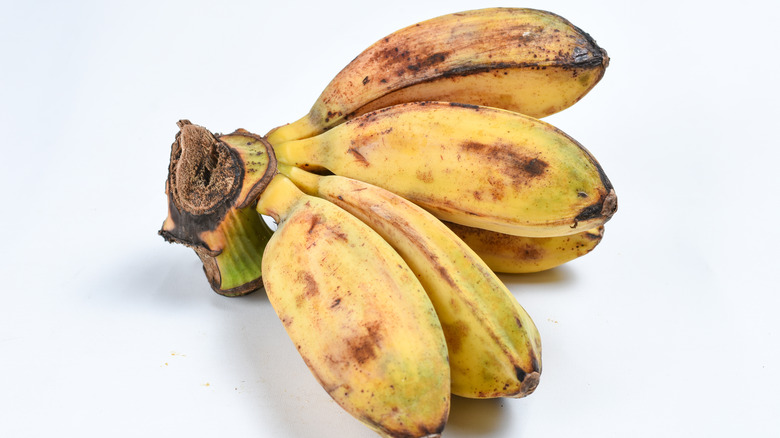Turon: The Crispy Banana Lumpia You Should Know About
A banana turon is nothing like the Spanish confection with a similar name, which is a piece of nougat filled with toasted nuts, which can be hard (Turrón de Alicante) or soft (Turrón de Jijona) per Culture Trip. Instead, the popular Filipino snack is made by taking a slice of a banana, rolling it in sugar, and then folding the sugared slice into a spring roll wrapper before deep-frying the whole thing, resulting in a sweet, addictive street food, per Kawaling Pinoy.
There is no one set way to make banana turon; some might choose to coat the fruit spring roll in caramel, others like adding a thin slice of ripe jackfruit to the banana before packing its contents away and frying, per Hungry Huy. Regardless of how it is made, turon can be found widely across the Philippines as a sweet way to end a meal or as a snack — from the posh lounges of exclusive hotels and restaurants, where they can set you back by as much as $13 per order, or at convenience stores where they can retail for 35 cents, per Yummy.
Lumpia: another kind of spring roll
Bananas are everywhere in the Philippines. Freebie MNL says there are 12 different types, so its not surprising that bananas are used in a variety of ways, including in a shaved-ice dessert, aka saba con Yelo, or fried up, sugared, and served on skewers or banana cues. Julee Ho Media posits that turon first came about because a surplus from banana harvests were given to families that lived in nearby plantations, who then took the bananas to sell at roadside kiosks.
But, it's not difficult to see the turon as a natural iteration of the love for deep-fried spring rolls, known as lumpia in the Philippines. Yummy says variations include rolls called lumpiang Shanghai that are stuffed with meat, lumpiang togue made with bean sprouts, and vegetables paired with tofu, known as lumpiang gulay. Spring rolls are also commonly served fresh, including the lumpiang sariwa, which is filled with pre-cooked vegetables like carrots, green beans, and jicama. The fresh Chinese lumpia is a Filipino version of the classic pohpia, or lumpia found in Singapore, Taiwan, and Malaysia per Tiny Urban Kitchen. The dessert lumpia, or banana turon, is an obvious answer to a sweet take on a savory favorite.
What you'll need to make banana turon
A good banana turon starts with the saba banana, also known as the sweet plantain, which is widely grown in the Philippines, per WebMD. Those of us for whom "banana" is synonymous with the yellow Cavendish, found all over the world, might not recognize the saba fruit, known for a thick peel and flesh that is starchy and firm. Despite the banana turon technique, this fruit is most nutritious when it is eaten raw: Saba bananas contain vitamins A, B, and C, says WedMD, and have a similar carbohydrate profile to a potato.
If you can't find saba bananas at the store, plantains will make a good substitute; however, Cavenish bananas get too mushy when cooked, per Always Kaye. Another key ingredient is jackfruit, a small slice of which is usually added with the saba inside the wrap. Unripe jackfruit might mimic the texture of pulled pork, but ripe jackfruit is as fruity as other tropical fruits including mango and pineapple, per Cleveland Clinic.
Turon is made by first rolling the banana in brown sugar to coat, adding a slice of jackfruit, and then folding both into a spring roll wrapper before frying until golden brown. It can be eaten hot or served when cold. Just don't forget the side of ice cream!


